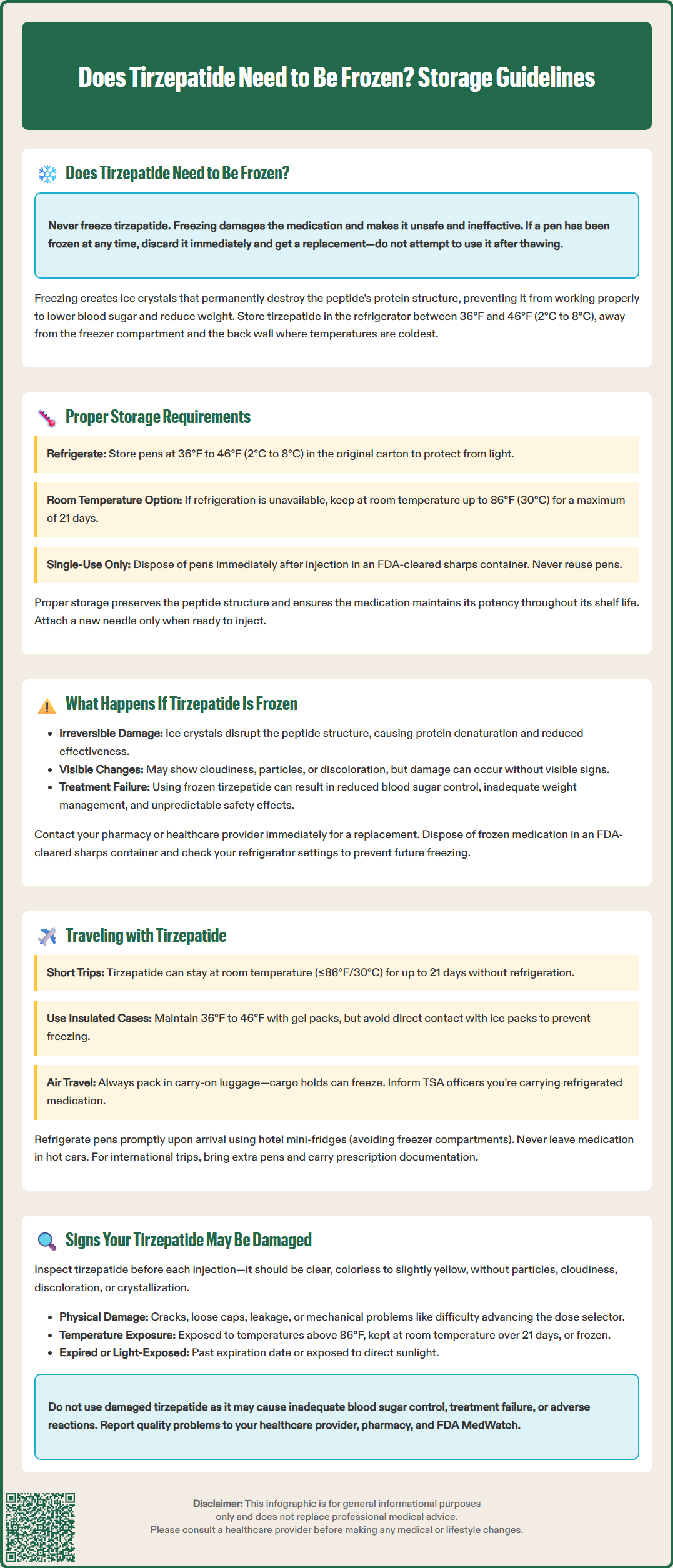LOSE WEIGHT WITH MEDICAL SUPPORT — BUILT FOR MEN
- Your personalised programme is built around medical care, not willpower.
- No generic diets. No guesswork.
- Just science-backed results and expert support.
Find out if you’re eligible

Does tirzepatide need to be frozen? This common question reflects confusion about proper storage for this dual GIP/GLP-1 receptor agonist used in type 2 diabetes and chronic weight management. Tirzepatide (Mounjaro, Zepbound) is a peptide-based medication requiring specific temperature control to maintain stability and therapeutic efficacy. Understanding correct storage practices—particularly the critical distinction between refrigeration and freezing—is essential for patient safety and optimal clinical outcomes. This article clarifies FDA-approved storage requirements, explains why freezing damages the medication, and provides practical guidance for patients and healthcare providers on maintaining tirzepatide integrity during storage and travel.
Quick Answer: Tirzepatide should never be frozen and must be refrigerated between 36°F and 46°F (2°C to 8°C) or kept at room temperature up to 86°F (30°C) for maximum 21 days.
Tirzepatide (Mounjaro, Zepbound) is a peptide-based prescription drug that acts as a glucose-dependent insulinotropic polypeptide (GIP) and glucagon-like peptide-1 (GLP-1) receptor agonist approved for type 2 diabetes management and chronic weight management. As a medication containing a peptide structure, tirzepatide requires specific storage conditions to maintain its stability, potency, and safety profile.
According to FDA-approved labeling, tirzepatide pens should be stored in a refrigerator at temperatures between 36°F and 46°F (2°C to 8°C). The medication should be kept in its original carton to protect it from light exposure, which can degrade the active pharmaceutical ingredient. If needed, a pen may be kept at room temperature (≤86°F/30°C) for up to 21 days before use. Proper refrigeration preserves the structural integrity of the peptide molecule and ensures consistent therapeutic efficacy throughout the product's shelf life.
It's important to understand that tirzepatide pens are single-dose devices. After injection, the pen and needle should be immediately disposed of in an FDA-cleared sharps container. Patients should only attach a new needle when ready to inject and should never attempt to reuse pens.
Healthcare providers should counsel patients on proper storage practices during initial prescribing and at follow-up visits. Pharmacists play a critical role in ensuring cold-chain integrity during dispensing and providing written storage instructions. Documentation of patient understanding regarding storage requirements supports medication adherence and optimal clinical outcomes in both diabetes management and weight reduction therapy.

Tirzepatide should never be frozen. Freezing is not a storage requirement for this medication and will actually damage the product, rendering it unsafe and ineffective for use. This is a critical distinction that patients and caregivers must understand to ensure medication safety and therapeutic efficacy.
The confusion about freezing may arise from general assumptions about refrigerated medications or misunderstanding storage instructions. While tirzepatide requires refrigeration between 36°F and 46°F (2°C to 8°C), this temperature range is specifically designed to keep the medication cold without approaching freezing temperatures. The freezing point of water is 32°F (0°C), which is below the recommended storage range and will cause irreversible damage to the peptide structure.
Peptide-based medications like tirzepatide contain complex protein structures that are sensitive to extreme temperatures. Freezing causes ice crystal formation within the solution, which physically disrupts the three-dimensional configuration of the peptide molecule. This structural damage cannot be reversed by thawing, and the medication loses its ability to bind effectively to GIP and GLP-1 receptors, compromising its glucose-lowering and weight-reducing effects.
Patients should position tirzepatide pens away from the freezer compartment in their refrigerator and avoid placing them against the back wall where temperatures may be coldest. If a pen has been accidentally frozen at any time, it must be discarded and replaced—never used. Healthcare providers should emphasize during patient education that "refrigerated" and "frozen" are distinctly different storage conditions, and only refrigeration within the specified range maintains medication integrity and patient safety.
When tirzepatide is exposed to freezing temperatures, irreversible physical and chemical changes occur that compromise the medication's safety and effectiveness. The formation of ice crystals disrupts the delicate peptide structure, causing protein denaturation and aggregation. These molecular changes alter the medication's pharmacokinetic and pharmacodynamic properties, potentially leading to reduced therapeutic efficacy or unpredictable effects.
Frozen and subsequently thawed tirzepatide may appear visibly altered. Patients might observe particulate matter, cloudiness, discoloration, or changes in solution consistency that were not present before freezing. However, in some cases, the damage may not be visually apparent, which is why any pen suspected of freezing must be discarded regardless of appearance. The absence of visible changes does not guarantee medication integrity after freezing exposure.
Using frozen tirzepatide poses several clinical risks. The compromised peptide structure may result in diminished glucose-lowering effects, inadequate weight management, and suboptimal glycemic control in patients with type 2 diabetes. Additionally, protein aggregation could potentially affect the medication's performance and safety profile.
Patients who discover their tirzepatide has been frozen should contact their pharmacy or healthcare provider immediately for a replacement. They should not attempt to use the medication or assess its safety through visual inspection alone. Insurance coverage for replacement pens due to storage errors varies by plan, but patients should contact their pharmacy, insurer, or the manufacturer's patient support program for assistance. The compromised medication should be disposed of in an FDA-cleared sharps container according to state and local guidelines. Patients should also review their refrigerator settings and storage practices to prevent recurrence.
Traveling with tirzepatide requires advance planning to maintain proper storage conditions and ensure medication availability throughout the journey. For shorter trips, patients may take advantage of tirzepatide's stability at room temperature (≤86°F/30°C) for up to 21 days before use. This flexibility significantly simplifies travel logistics while maintaining medication stability and efficacy.
For longer trips or when carrying multiple pens, patients should use insulated medication travel cases or cooling pouches specifically designed for injectable medications. These products typically contain gel packs that maintain temperatures within the required 36°F to 46°F (2°C to 8°C) range without freezing the medication. Patients should avoid placing tirzepatide directly against ice packs or frozen gel packs, as direct contact can cause localized freezing. A barrier layer, such as a small towel or the medication's original packaging, provides protection.
Air travel presents specific considerations. According to Transportation Security Administration (TSA) guidelines, tirzepatide should be carried in carry-on luggage rather than checked baggage, as cargo hold temperatures can drop below freezing at high altitudes. The TSA permits medications in carry-on bags, and patients should carry their prescription label or a letter from their healthcare provider documenting medical necessity. When passing through security, patients should inform officers they are carrying refrigerated medication. X-ray screening is permitted for medications, though patients may request hand inspection if preferred.
Upon reaching their destination, patients should refrigerate their pens promptly. Hotel mini-refrigerators are generally adequate, though patients should verify the temperature setting and avoid the freezer compartment. Never leave medication in hot cars, which can quickly exceed safe temperature limits. For extended international travel, patients should research medication availability at their destination and carry sufficient supply plus extra pens in case of loss or damage. Travel insurance covering medication replacement and consultation with a travel medicine specialist may be advisable for complex itineraries or destinations with extreme climates.
Recognizing signs of tirzepatide damage is essential for patient safety and therapeutic efficacy. Patients should visually inspect their medication before each injection, examining the solution through the pen's viewing window if visible. Undamaged tirzepatide should appear as a clear, colorless to slightly yellow solution without visible particles, cloudiness, or discoloration. Any deviation from this appearance suggests potential degradation or contamination.
Specific visual indicators of damage include particulate matter (floating particles or sediment), cloudiness or turbidity, color changes (darkening or unusual tints), crystallization, or separation of solution components. Additionally, physical damage to the pen itself—such as cracks in the cartridge, a loose or damaged cap, evidence of leakage, or a pen that has been dropped from significant height—may compromise medication integrity even if the solution appears normal. Patients should also be alert to changes in the pen's mechanical function, such as difficulty advancing the dose selector or resistance during injection.
Beyond visual inspection, patients should maintain awareness of storage history. Tirzepatide that has been exposed to temperatures above 86°F (30°C), kept at room temperature for more than 21 days before use, frozen at any time, or kept past its expiration date should not be used regardless of appearance. Exposure to direct sunlight or prolonged light exposure may also degrade the medication without obvious visual changes.
If any signs of damage are present or storage conditions have been compromised, patients should not use the medication and should contact their pharmacy or healthcare provider for guidance. Using damaged tirzepatide may result in inadequate glycemic control, treatment failure, or adverse effects. Patients experiencing unexpected hyperglycemia, lack of appetite suppression, or unusual injection site reactions after using questionable medication should seek medical evaluation. Quality problems or adverse events should be reported to the FDA MedWatch program and the manufacturer. Proper documentation of medication lot numbers and storage incidents assists healthcare providers in assessing potential medication-related issues.
No, tirzepatide that has been frozen at any time must be discarded and replaced, as freezing causes irreversible damage to the peptide structure that compromises safety and effectiveness. Contact your pharmacy or healthcare provider for a replacement pen.
Tirzepatide pens may be kept at room temperature up to 86°F (30°C) for a maximum of 21 days before use. After this period, any unused pens should be discarded even if they appear normal.
Carry tirzepatide in your carry-on luggage rather than checked baggage to avoid freezing temperatures in cargo holds. Use an insulated medication travel case with gel packs, ensuring the pen does not directly contact frozen gel packs, and inform TSA officers you are carrying refrigerated medication.
All medical content on this blog is created using reputable, evidence-based sources and is regularly reviewed for accuracy and relevance. While we strive to keep our content current with the latest research and clinical guidelines, it is intended for general informational purposes only.
This content is not a substitute for professional medical advice, diagnosis, or treatment. Always consult a licensed healthcare provider with any medical questions or concerns. Use of this information is at your own risk, and we are not liable for any outcomes resulting from its use.